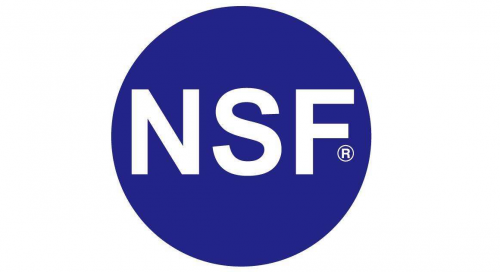Introduction: When choosing a water purifier, the “NSF Certified” mark is a gold standard for reliability. But does an NSF-certified purifier guarantee absolute safety? What does “NSF grade” actually mean? Have you considered the science behind this seal and its crucial connection to a seemingly small yet vital component inside your purifier—the rubber seal? This article delves into NSF’s dual roles, answers key questions, and reveals how core components work together to safeguard your water.
1. NSF: Dual Missions as a Scientific Foundation and Safety Guardian
NSF encompasses two key entities building defenses for scientific progress and product safety:
- National Science Foundation (NSF):
- A U.S. federal agency established in 1950 with a core mission to advance scientific progress.
- Funds basic research (e.g., space exploration, genetics, environmental science), providing the knowledge foundation for national health, prosperity, welfare, and security.
- Its research fuels technological innovation and high-tech industries.
- NSF (formerly NSF International):
- An independent, non-profit, non-governmental organization founded in 1944, serving as a global authority in public health and safety.
- Core Business: Developing product standards, testing, and certification services covering water, food, health sciences, and consumer goods.
- Goal: Minimize health risks and protect the environment.
- Authority: Operates in 180+ countries, a Collaborating Centre with the World Health Organization (WHO) for food safety, water quality, and medical device safety.
- Many of its drinking water treatment standards are adopted as American National Standards (NSF/ANSI Standards).

2. NSF Certification: The Benchmark for Water Purifier Performance & Safety
As consumer concern for drinking water safety grows, water purifiers have become a primary choice for home health protection. NSF’s certification system is the scientific benchmark assessing if a purifier truly delivers on its purification claims.
- Rigorous Standards: NSF establishes strict standards for water purifiers. Key examples include:
- NSF/ANSI 42: Addresses aesthetic effects (taste, odor, particulates like chlorine).
- NSF/ANSI 53: Mandates requirements for reducing specific health contaminants (e.g., lead, pesticides, VOCs, THMs, asbestos). Certification means effective reduction.
- NSF/ANSI 401: Targets emerging/incidental contaminants (e.g., some pharmaceuticals, pesticide metabolites).
- NSF P231 (Microbiological Water Purifiers): Specifically evaluates systems for microbial reduction (e.g., bacteria, viruses, cysts).
- NSF P535 (For China Market): Designed for drinking water treatment devices in China. Covers material safety, basic performance requirements, and verifies reduction claims for specific contaminants (e.g., lead, mercury, PFOA/PFOS, BPA).
- Key Question Answered: What does NSF grade mean?
- Crucial Clarification: NSF certification is NOT a “grading” system (e.g., Grade A, B). There is no such thing as an “NSF grade.” NSF certification is a Pass/Fail verification against specific standards.
- Core Meaning: A water purifier claiming NSF certification means it has passed independent NSF testing and evaluation for one or more specific standards (e.g., NSF/ANSI 53, NSF P231) that it claims to meet. Each standard addresses different contaminant reduction capabilities or material safety requirements.
- Consumer Focus: Instead of seeking a non-existent “grade,” consumers should focus on which specific NSF standards the product has passed (usually listed in product specs or verifiable via NSF’s online database). For example, a purifier claiming “NSF Certified” may only have passed NSF/ANSI 42 (aesthetic improvement), not NSF/ANSI 53 (health contaminant reduction). Knowing the specific certifications is vital.
- Market Value:
- Consumer Trust: Clearly labeled specific NSF certifications are a key trust identifier for buyers, signifying the product has undergone rigorous independent testing for claimed capabilities (contaminant reduction, material safety).
- Brand Advantage: For manufacturers, achieving demanding NSF certifications (like P231) is powerful proof of product quality, significantly enhancing brand reputation and competitiveness.
- Case Studies:
- Multipure Aqualuxe: Utilizing high-pressure sintered carbon block technology, it achieves 99.99% virus reduction, 99.9999% bacteria reduction, and effectively reduces 100+ contaminants. It’s the world’s only single-stage system certified to NSF P231 (Microbiological Purifiers). (Demonstrates passing a stringent microbial standard, not a vague “grade”)
- Philips Water: 20 of its reverse osmosis water purifiers successfully achieved NSF P535 certification, making it the first domestic company in China to do so, solidifying its market leadership. (Highlights meeting a comprehensive standard tailored for China)
3. The Water Purifier’s “Unsung Hero”: The Critical Role of Rubber Seals
Within a purifier’s intricate design, rubber seals are small but indispensable “guardians.” NSF certification doesn’t just assess filter performance; its strict “material safety” requirements directly apply to critical components like seals.
- Core Function: Ensure absolute sealing of the water pathway (filter housings, pipe connections), preventing leaks and cross-contamination between untreated and treated water. They are fundamental for safe and effective operation.
- Quality Risks: Poor-quality seals can cause leaks, failure, or leach harmful substances. This severely compromises purification performance, pollutes the treated water, damages the unit, causes property damage (e.g., flooded floors), and poses health risks. Even with certified high-performance filters, seal failure or contamination can undermine the entire system’s safety and the validity of the NSF certification.
4. Fortifying the Last Line of Defense: High-Performance Rubber Seals
We specialize in providing high-performance rubber seal solutions for the water purifier industry, understanding their critical importance for system reliability and maintaining NSF certification validity:
- Material Safety: Strict selection of NSF-compliant materials (e.g., meeting NSF/ANSI 61 for drinking water system components), rigorously tested to ensure no leaching, migration, or contamination over long-term water contact, safeguarding water purity and meeting NSF’s material safety mandates.
- Precision Manufacturing: Advanced production techniques ensure high precision and superior sealing performance for long-term stability in complex water systems.
- Rigorous QC: Multi-stage quality control (aligned with NSF testing requirements) from raw materials to finished goods guarantees reliable, durable products.
- Exceptional Performance:
- Superior Aging Resistance: Maintains excellent elasticity and sealing under prolonged moisture, varying temperatures, and pH levels, extending lifespan and ensuring long-term compliance.
- Reliability: Significantly reduces leaks, performance drops, or repairs due to seal failure, delivering durable, worry-free, safe operation.
- Customization: Ability to provide tailored seal solutions based on specific purifier brand/model designs and NSF certification requirements.
Conclusion: Certification ≠ Vague Grade, Precision Parts Ensure Ongoing Safety
NSF certification is scientific validation that a water purifier meets specific safety and performance benchmarks through rigorous testing, providing clear guidance for consumers. Remember, it signifies passing concrete standards, not an ambiguous “grade.” However, a purifier’s long-term safety and certification validity depend equally on the excellence and durability of its internal core components, like rubber seals. Together, they form a complete chain safeguarding household drinking water. Choosing a purifier with clearly stated NSF certifications (e.g., NSF/ANSI 53, NSF P231, NSF P535) and ensuring the quality of its core components (especially safety-critical seals) is the smart choice for consumers seeking long-term, reliable, healthy drinking water.
Post time: Aug-19-2025
